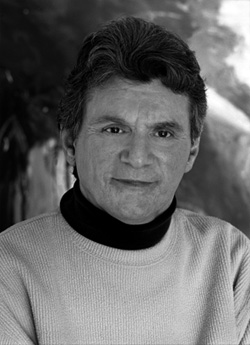
Portrait of Rick Burns, Strathbutler 2000 (photo – James Wilson)
… to describe, through the drawing and sculpture, the constant fight to become whole …
Rick Burns won the Strathbutler Award in recognition of his outstanding achievements as a visual artist as well as his leadership and vision in the cultural community.
Born in Middleton Nova Scotia, he studied at the University of New Brunswick and later apprenticed in sculpture with Rosemary James Cross. A published writer of short stories and plays, Burns felt that sculpture opened his eyes to more possibility in the visual arts world. Painting, drawing, collage, sculpture and installation have all allowed him to deeply explore the themes of boundaries, constraint and security. Beginning with his first solo exhibit at the Landmark Gallery in 1980 he has exhibited widely; his work is found in both private and public collections.
The theme of containment has served as a thematic focus throughout his career as an artist. This theme has taken many forms and been presented through a series of metaphors that explore the physical and imaginative constraints placed on the body. His unwavering project is to describe the constant struggle to become whole through a creative life, to move away from physical corruptibility toward equilibrium
- A Gallery of Rick Burns’ work
- All posts on Rick Burns
For many years, Burns devoted his energies to teaching at the New Brunswick College of Craft and Design, and mentoring developing artists. In 1987 he was a appointed to the Cultural Task Force of the NB Arts Board responsible for creating provincial cultural policy He was a founding member of Gallery Connexion, an artist run centre in Fredericton, launching a co-operative gallery which promotes alternative forms of expression.
In the artist’s words
On accepting the Strathbutler nomination:
My work originates in autobiographical sources. However, its visceral play of bodily absence and presence can hardly be isolated from the larger context of its production. Rooted in the familiar-clothing, furniture-this sculpture is close to the body, inherently personal in its connotations and scale.
I continue to describe, through the drawing and sculpture, the constant fight to become whole. To move away from physical corruptibility and move toward equilibrium.
On being in a wheelchair
I always get asked if being in a wheelchair affects my artwork. Of course it has to affect it … I can’t pretend that I don’t exist in this particular form. I can’t for one minute pretend that I’m not running around in this wheelchair. But I think the issues are much larger than just about me being confined to a wheelchair. I think that is very limiting and I would like the work to have a much broader scope.
On his inspiration
Essentially, I’m concerned about the body as subject matter. And primarily the absence of the body. Using the body blatantly just seemed a little too obvious. By objectifying the body, I can talk about issues that concern me as a visual artist and as an individual, which means I can work very autobiographically.
